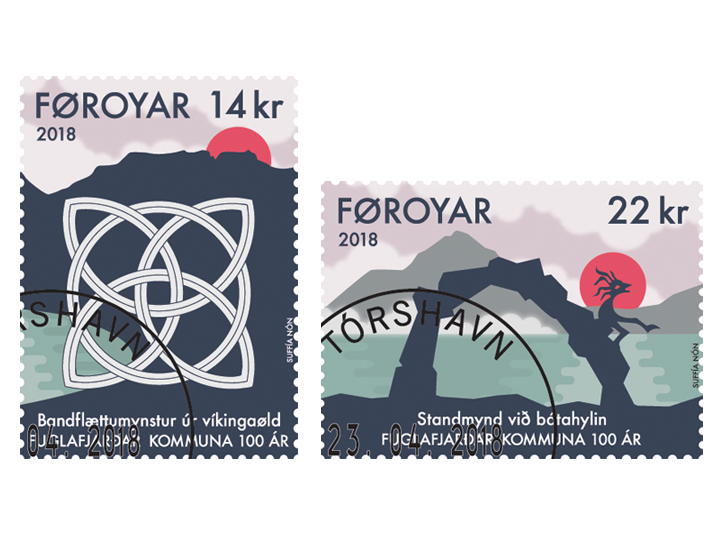| Item No. | Vørunavn | Eind | Mynd | Prísur v/MVG |
|---|

Fuglafjørður 1918 – 2018
Issue Date: 4/23/2018
Item No.: DDG020418
Value: 36,00
Municipality for 100 years – creative community for 1000 years
In the north-eastern part of the island of Eysturoy, there is a small, yet lively town called Fuglafjørður. Nestled snuggly at the bottom of a sheltered fjord and shielded by the seven mountains surrounding it, its inhabitants are ensured a relatively mild climate. This location was well suited for a thriving settlement with its good conditions for progress: a natural harbour close to good fishing grounds next to a river and fertile soil. Despite the tall mountains, the sun reaches the town throughout the year.
Archaeological excavations
Historical records telling us about the early history of the village are sparse. However, in 1958 Sverri Dahl, archaeologist, supervised an excavation near the river, Gjógvará, which revealed that people have lived in Fuglafjørður since the Viking Age. The excavation uncovered the remains of different houses over several periods from the Viking Age and throughout the Middle Ages, as well as many interesting artefacts. The oldest settlement and the objects found at the site date back to the Viking Age, probably from around AD 900 – 1000. This was a longhouse akin to the remains found in the villages of Leirvík and Kvívík. These longhouses were usually between 15 and 20m long, but centuries of erosion along the coast have washed away one end of the house. Among the relics found in the dig were fragments of several wooden and soapstone vessels, whetstones, wooden toys and glass beads of various colours. A a line-sinker of stone was also found – engraved with the Saint John’s Arms (or the Saint Hannes Cross). This looped square is the symbol we know today from signs and maps, indicating a place of interest.
The Celtic Quaternary Knot
A unique find among the oldest remains was a wooden board which has probably been the lid of a small chest. A carved relief of a double plait weaves a regular interlace pattern across the lid. The board itself is broken so only a part of the vague pattern remains, but it is distinct enough to recreate the original design (cf. the stamp). This embellishment is one of many examples of Celtic or Celtic-inspired designs that become part of the blended Celtic-Norse culture of the Viking Age. The pattern is known today as the Celtic Quaternary Knot.
This is the only piece of wood from the Viking Age with a carved Celtic design found in the Faroe Islands so far. However, there have been other finds with Celtic or Celtic-inspired decorations, e.g. bronze needles and a bronze clasp.
The double plait pattern on the wooden board from Fuglafjørður is a beautiful and mythical pattern testifying to a daily life a thousand years ago which also had room for artistic pursuits despite harsh living conditions. Many settlers came from Celtic areas in Scotland and Ireland, and they may have brought the chest with them, but the design may also have been carved into the lid on long winter nights by the fire in the longhouse by the beach near Gjógvará river.
Many questions may arise when we contemplate such finds. What has an ordinary day looked like for the settlers? Who were they? Was the chest used to store the beads? Did the owners abandon the site, or what happened to them? Did the design hold some symbolic or religious meaning, or was it just a part of the Celtic-Norse fashion? In any case, the design still fascinates us today as a reminder of the past and an inspiration for the future.
The Gate to the World
The desire to create something anew still exists here. Fuglafjørður is known as a town of creative people and interesting events. Here you will find capable choirs, a swinging brass band, an active Arts & Crafts Centre with an old shop and Gallery, Ribarhus, a culture house hosting a variety of events, artists, and various sports clubs. In addition, there are several festivals, e.g. the summer town fair called the Hot Spring Festival, the Knitting Festival, the Accordion Festival and the Culture Days.
In 2004, the town fair, whose main attraction is
usually the rowing competition, was turned into an Art Festival called Man and
Myth. Both local and visiting creative artists were involved in the Art
Festival where they collaborated on creating both momentary and permanent experiences.
A cantata was made for the festival, there was a modern dance show in the
marina, and several art exhibitions around town were among the many events. On
the jetty between the fjord and the marina, a series of sculptures was erected,
which still attracts attention in our town. It was created by the Danish art
group 7-9-13 with Anette & Michael Arleth and Em Hess. This work is called
the Gate to the World and consists of five large iron sculptures depicting a
boulder gate, suggestive of the entrance to old Faroese houses. One of the
gates can be seen on the stamp. This family of sculptures is inspired by the
poetical paper cuttings of renowned Faroese author and artist William Heinesen
and his universe of sea people, with fish and birds weaving in and out of the gates.
The artwork plays on the contrasts between the frail paper cuttings and the
more permanent, if rusty, iron material, between myth and industry, art and
boulders, situated as it is on the edge of sea and town, between untamed nature
and the civilized community, a gate out to the world and into our hometown.







